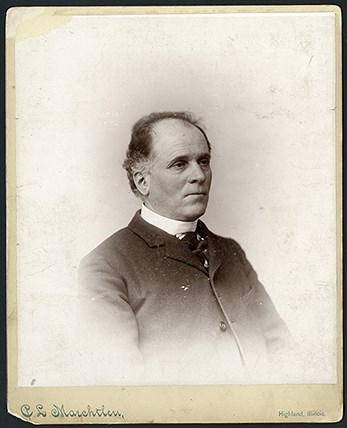
C.L. Maechtlen, Courtesy Palace of the Governors Photo Archives (NMHM/DCA), 009138 Over the next few months, he explored caves and discovered pueblos and the remains of irrigation canals. At times, he had traveling companions, including Henry Hunting, a local rancher from Show Low, AZ. From there, the pair traveled 40 miles in a buckboard to Fort Apache. Following behind was Chico, Bandelier's horse, unencumbered with a rider. It took Bandelier and Hunting an entire day to reach the Fort. Bandelier spent several days exploring sites around the Fort, including the Kinishba Pueblo sites. He also dealt with a nasty case of food poisoning. While at Fort Apache, he was informed of the news of his own death: "To my terrible dismay, [we received] a dispatch...stating my capture and murder by Geronimo.... I immediately telegraphed home, and wrote letters home." A week later, Bandelier commented in his journal that newspapers were still carrying news of his death. "My obituaries are, so far, flattering..." Undeterred, Bandelier continued southeast to Fort Thomas, explored for a few days, and then backtracked to San Carlos before continuing toward Globe, AZ. Riding through the San Carlos Apache Reservation, he noted in his diary: "All day I traveled among the Apaches, and they are very friendly." Bandelier seems to have always been able to establish and maintain warm relations with everyone he encountered, even on the San Carlos Reservation where violence corruption, hostility, and malaria, flared up frequently. Once in Globe, he traveled to the site now known as Besh-Ba-Gowah. Though completing only a cursory survey, he noted that it was extensive, with stone built rooms, and open courts, though "No traces of estufas [i.e. kivas] were visible..." He then moved north toward the Tonto Basin roughly along what is now Highway 188. On May 23, 1883 he notes "the mountains are terribly rugged, craggy, and bare." At the south end of the basin, he located ruins of large pueblos on bench lands and saw "some beautiful pottery." He was probably at Schoolhouse Point at the east end of Roosevelt Lake, about where the reservoir begins. The next day, he and two unnamed companions went by horseback to explore dwellings in a canyon south of the Salt River. They first visited the lower cave which Bandelier described thusly: "Into it the house has been built. It is a perfect pueblo house but small." With these words, scientific research began on the Lower Cliff Dwelling . That same day, Bandelier led his horse past the spring which provided water for the cliff dwellers and which still provides water for the Monument. The Upper Cliff Dwelling stands some 250 feet above the lower and is about twice its size. The two sites he described were eventually incorporated into Tonto National Monument, administered by the National Park Service. Read Bandelier's own description of his journey to the Tonto Cliff Dwellings. On May 26, Bandelier and Chico crossed to the north side of the river. He recorded in his journal that "Chico did not like to cross the Salt River, which is very swift and as broad as the Gila at San Carlos, but only 'belly deep.'" After another month of travel and exploration, Bandelier left a very tired and sore Chico in the care of an Army surgeon in Tucson and made his way by train to Albuquerque. He spent the summer with his family in Santa Fe, went briefly to the family home in Illinois, but was back in the southwest by the end of October where he continued traveling and exploring, sometimes with Chico. He traveled extensively between Illinois, New York, Europe, Mexico City, and Santa Fe. He undertook a multi-year expedition to Peru and Bolivia, tracing the ancient Incas. He returned to New York in 1903 where he and his second wife lived until 1913, when they left to search colonial records in Spain. He died in Seville, Spain in March 1914. Born in Switzerland; brought to the United States as a child; explorer of culture and prehistory in the US, Mesoamerica, and Europe, died in Spain: Adolph Francis Bandelier embraced the past while showing the way to the future. References:Moore, Will. "Adolph Bandelier in the Arizona Territory 1883-1884." The Journal of Arizona History, Winter 2014, pps. 415-452 |
Last updated: October 11, 2020
